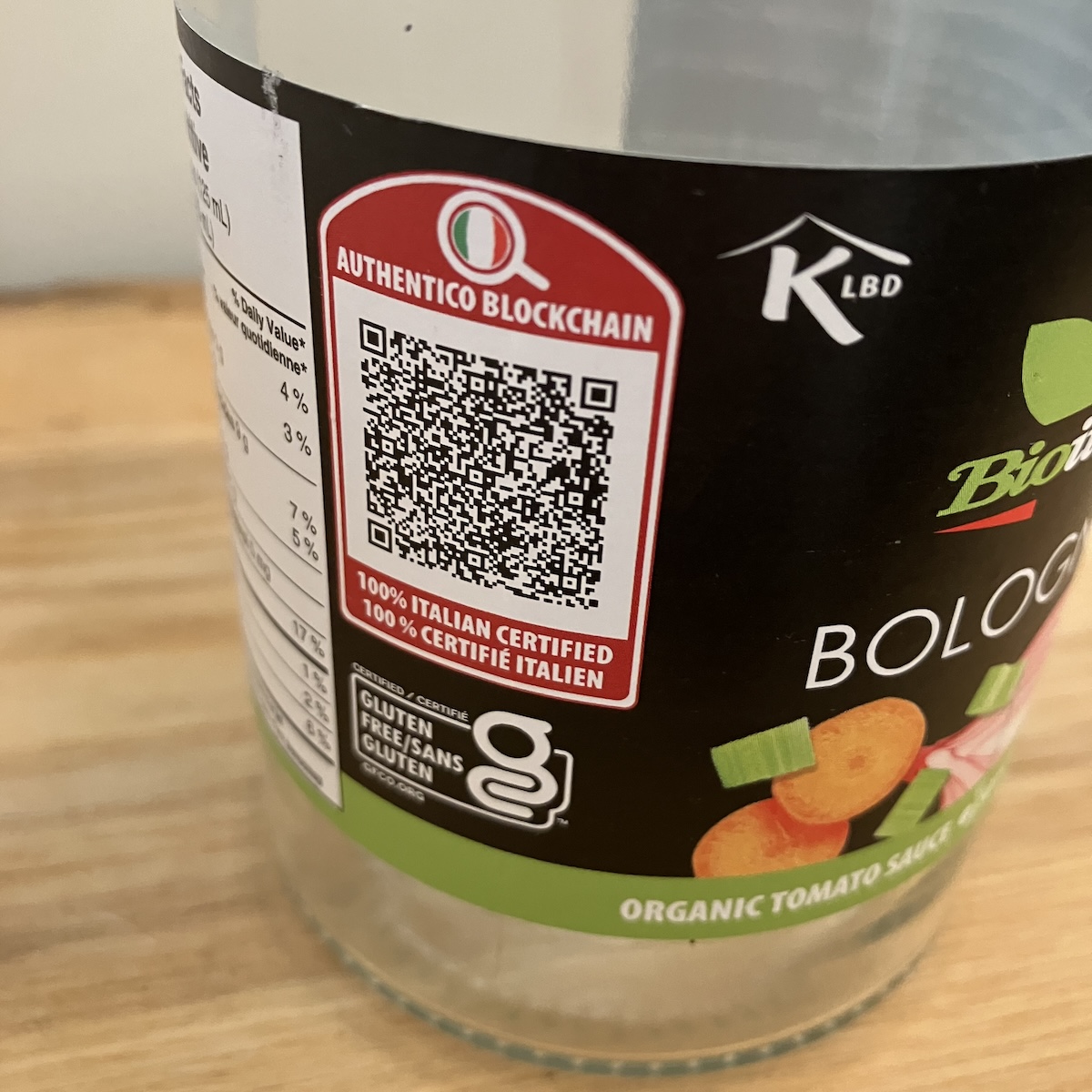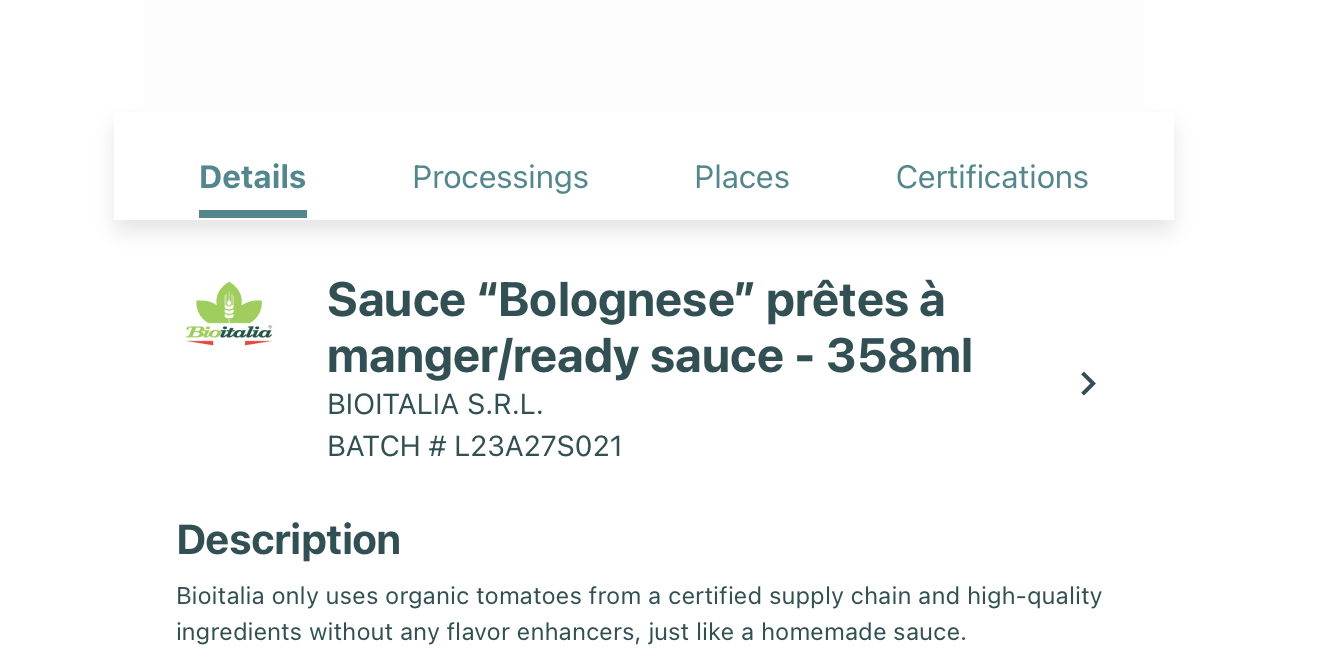
I've been a crypto lawyer
for a decade now. So I did a double-take when I looked at the label on the pasta sauce I'd just eaten: a blockchain authentication label! Blockchains out in the real world. The above picture is the actual pasta sauce I ate. And the link on the QR code goes to this page: https://blockchain.authentico.it/q/?query=f00d00000000000100000000018e7bef3193d4d4b939f8150d73a11016e86fbe&show_cookies=1.

Blockchains Impacting Food Authentication
Although I've been talking about blockchains and supply chains, and doing work in this area, for many years, it's surprising to see a household food product with a blockchain label on it! It's heartening to see these technologies be deployed in the service of stopping food fraud and giving people better insight into what they're eating. Existing food supply chains are incredibly opaque, and any initiative that lets consumers see under the hood is a great one. And I'm not surprised at all to see that this innovation comes from Italy.
From the webpage, the user can look at the company's organic certifications, such as this mass approval document issued by the European Union. There's also information about the steps involved and the ingredients.
The Data Problem: Missing Information
Like all computer systems, a blockchain-based one can't make information more available than what people put into it. In this case, the makers of the pasta sauce haven't included all of the ingredients, so the consumer only gets to read about the tomatoes. That's better than any other manufacturer, but it's unfortunate that the product information isn't complete. The Places
section only shows the company's headquarters, not where the actual food is made, and the processing steps are generic. This isn't the fault of the system developers. It's the fault of the user, Bioitalia, that hasn't inputted all of the information. Everyone who's worked on computer systems knows how common this problem is, and no amount of blockchain authentication can make this problem go away.

Where's The Blockchain?
Everything on the product page is a plain link. Where's the blockchain? It's not apparent to the user how they verify any of this information hasn't been altered, which is surely the purpose of connecting the data to a blockchain. Did they change the website yesterday? The user can't tell. There's no hash or link to a block explorer. The makers of the software don't explain this anywhere on their website. I'm actually not sure if there's any blockchain involved at all.
If it's true that there's no blockchain involved in the Blockchain Authentico product, that's more than a little ironic. That would be so ironic, that I can't believe that there isn't a blockchain somewhere in this product, but I can't see where. Maybe I'm looking in the wrong spot, or there's something about this I don't understand, but if that's the case, it's not a particularly strong use case, because the idea of linking to a blockchain is to provide greater assurance. Without having any way of connecting what you're seeing to a blockchain, the user is left without a greater sense of trust than they would have if there's no blockchain involved. The company's YouTube video doesn't clarify this but a blog post mentions that they're using the Quadrans blockchain. It's unclear how.
The Quadrans blockchain seems to have very little activity, with only one Twitter post and very little activity on Github lately. It seems to be a fork of Ethereum that claims to combine PoW and PoS. It looks like the project has stalled, and I expect Blockchain Authentico will likely move to another Ethereum-compatible network, probably one of the many L2 systems.
The system could be improved by exposing the blockchain functionality to the user, and drawing their attention to how the blockchain side of the product is ensuring greater authentication. Because it's a good use case, but this product doesn't give any more consumer confidence than a simple QR code posting to additional information about how the product is made, something that's already provided by manufacturers. Although in the case of this specific bolognese sauce, the manufacturer provides much less information about certifications and how the product is made on their own website.
Fake Products Could Use The Same Labels
What's stopping a fake product from putting the same QR code on their goods? Trademark infringement with the Authentico trademark is one issue, but if they're faking the look of authentic foods, would anyone stop at faking the authentication company's label? Since the labels are just links that anyone could copy, I'm not sure how the label helps.
The manufacturers would need to do more than just have a static label in order to link the actual product to a supply chain. At the moment that's not a part of the product.
Great Concept
It's a great concept, to provide extended product information about the supply chain that led to your dinner. But the execution doesn't seem to be where I'd expect it to be, for a company like Bioitalia to be using it (they're a common brand of Italian-made food in Canada).
Maybe in the future there'll be a blockchain (if there isn't already). Maybe the processing steps will get more specific, like videos of factories or photos that show the actual products being put into bottles. It's certainly possible, but would require far more technology (and cost) than is justified by the probably rather weak demand for this level of insight into how food is made. Eventually, maybe food will have QR codes that link to AI-generated cuts of factory production, in the style of How It's Made. GPS locations of where tomatoes were picked? Cryptographic chips embedded in lids so that products can be verified? I'm curious to see where these developments go.
